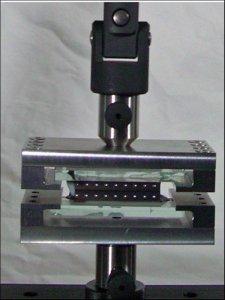
A bonding test is used to determine the ability of an adhesive to remain in contact with a surface or material while under stress or the adhesive’s ability to hold together two materials as they are stressed. The bond itself is tested after it has been applied and allowed to cure by either applying a force directly to the adhesive in an attempt to remove it from the material or by attempting to separate to materials to have been connected to each other by the adhesive. The force is then either steadily increased or remains constant and is applied to the bond until it fails.
Purpose of Bonding Testing:
Bond tests determine an adhesives’ bond strength. The bond strength of a material may be considered to be its overall “stickiness” and will depend on the type of stress the bond experiences and the temperature at which the test is run. This strength will also depend upon the direction of the force applied to the bond. For example a bond may require more force to be broken in shear than in direct tension.
Types of Bonding Tests:
There are many different types of bond testing, but the most commonly performed are tensile, shear and peel testing with torsional, impact, and pull-off tests performed less often. Each bond test is used to determine the adhesives bond strength in a given direction or under a given type of stress. Nearly all bond testing will take one of two forms. Either the adhesive will be applied to the surface of a material as a type of coating and the adhesives’ bond strength is determined to be its ability to remain in contact with the material while under stress or the adhesive is applied between two rigid substrates and its bond strength is determined as its ability to hold the two substrates together while under stress.
Types of materials:
Generally a bond test is performed on an adhesive; however this adhesive can consist of a wide range of materials or come in several forms. The more popular types of adhesives that undergo bond testing are composed of polymers, composites, grouts, mortars, and glues. These adhesives may be applied to all types of materials but are often tested when adhered to metals, plastics, ceramics, woods and dental materials (e.g. dentine and enamel). The adhesive is generally tested when bonded between two rigid substrates, but may also be tested when applied as a coating or as the bonding material between a flexible coating and a rigid substrate.
Selected Test Standards
- ASTM A944 Bond Strength Steel Reinforcement Rebar Test Machine
- ASTM C297 Tensile Testing for Sandwich Panels
- ASTM C633 Thermal Spray Coatings Adhesion Test Equipment and Solutions
- ASTM D1002 Lap Shear Testing for Adhesively Bonded Metals
- ASTM D3163 Lap Shear Rigid Plastic Test Equipment
- ASTM D3330 - Peel Adhesion Pressure Sensitive Adhesive Tapes
- ASTM D3762 Adhesive-Bonded Surface Durability of Aluminum (Wedge Test)
- ASTM D429 - Rubber to Metal Adhesion Test Equipment
- ASTM D4501 Block Shear Strength Testing Equipment for Adhesive Bonds Between Rigid Substrates
- ASTM D4884 Strength of Sewn or Thermally Bonded Seams of Geotextiles
- ASTM D5041 Fracture Strength in Cleavage of Adhesives in Bonded Joints
- ASTM D5868 Lap Shear Adhesion Plastic Bonding
- ASTM D897 Tensile Strength Test Equipment for Metal to Metal Adhesive Bonds
- ASTM D903 180 degree Peel Strip Strength of Adhesive Bonds
- ASTM D905 Wood Adhesive Bonds in Shear by Compression Loading
- ASTM D952 Bond Cohesive Strength of Sheet Plastics and Insulating Materials
- ASTM E190 Guided Bend Test Equipment for Ductility of Welds
- ISO 13445 Block-Shear Method for Shear Strength of Adhesive Bonds between Rigid Substrates
- ISO 4587 Tensile Lap-Shear Strength of Rigid-to-Rigid Bonded Assemblies
- ISO 8510 Peel Test for an Adhesive Flexible-to-Rigid Bonded Test Specimen Assembly
Selected Applications
- Adhesive Peel Stripping Strength of Bonds
- Axially Loaded Butt Joint Test of Adhesives
- Bond Strength Thermal Spray Coating Test Equipment
- How to determine bond test machine requirements
- Dental Adhesive & Material Tensile Adhesion Bond Strength
- Bond Strength Testing of Plastics
- Bond Strength Testing of Cement
- Bond Strength Testing between an Adhesive and Metal
- Plastic Pipe and Pipe Welds Testing
